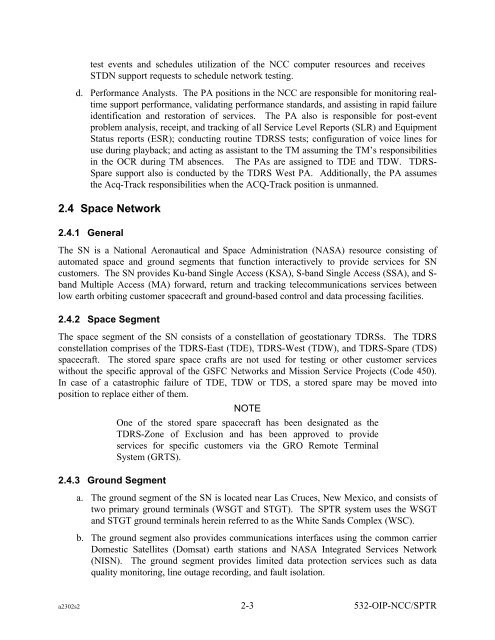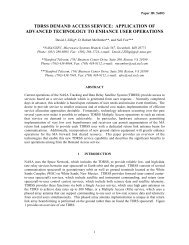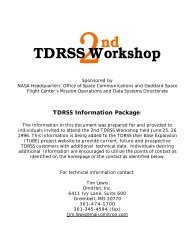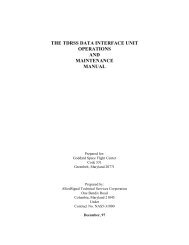Operational Interface Procedures for the South Pole TDRSS Relay ...
Operational Interface Procedures for the South Pole TDRSS Relay ...
Operational Interface Procedures for the South Pole TDRSS Relay ...
Create successful ePaper yourself
Turn your PDF publications into a flip-book with our unique Google optimized e-Paper software.
test events and schedules utilization of <strong>the</strong> NCC computer resources and receives<br />
STDN support requests to schedule network testing.<br />
d. Per<strong>for</strong>mance Analysts. The PA positions in <strong>the</strong> NCC are responsible <strong>for</strong> monitoring realtime<br />
support per<strong>for</strong>mance, validating per<strong>for</strong>mance standards, and assisting in rapid failure<br />
identification and restoration of services. The PA also is responsible <strong>for</strong> post-event<br />
problem analysis, receipt, and tracking of all Service Level Reports (SLR) and Equipment<br />
Status reports (ESR); conducting routine <strong>TDRSS</strong> tests; configuration of voice lines <strong>for</strong><br />
use during playback; and acting as assistant to <strong>the</strong> TM assuming <strong>the</strong> TM’s responsibilities<br />
in <strong>the</strong> OCR during TM absences. The PAs are assigned to TDE and TDW. TDRS-<br />
Spare support also is conducted by <strong>the</strong> TDRS West PA. Additionally, <strong>the</strong> PA assumes<br />
<strong>the</strong> Acq-Track responsibilities when <strong>the</strong> ACQ-Track position is unmanned.<br />
2.4 Space Network<br />
2.4.1 General<br />
The SN is a National Aeronautical and Space Administration (NASA) resource consisting of<br />
automated space and ground segments that function interactively to provide services <strong>for</strong> SN<br />
customers. The SN provides Ku-band Single Access (KSA), S-band Single Access (SSA), and Sband<br />
Multiple Access (MA) <strong>for</strong>ward, return and tracking telecommunications services between<br />
low earth orbiting customer spacecraft and ground-based control and data processing facilities.<br />
2.4.2 Space Segment<br />
The space segment of <strong>the</strong> SN consists of a constellation of geostationary TDRSs. The TDRS<br />
constellation comprises of <strong>the</strong> TDRS-East (TDE), TDRS-West (TDW), and TDRS-Spare (TDS)<br />
spacecraft. The stored spare space crafts are not used <strong>for</strong> testing or o<strong>the</strong>r customer services<br />
without <strong>the</strong> specific approval of <strong>the</strong> GSFC Networks and Mission Service Projects (Code 450).<br />
In case of a catastrophic failure of TDE, TDW or TDS, a stored spare may be moved into<br />
position to replace ei<strong>the</strong>r of <strong>the</strong>m.<br />
NOTE<br />
One of <strong>the</strong> stored spare spacecraft has been designated as <strong>the</strong><br />
TDRS-Zone of Exclusion and has been approved to provide<br />
services <strong>for</strong> specific customers via <strong>the</strong> GRO Remote Terminal<br />
System (GRTS).<br />
2.4.3 Ground Segment<br />
a. The ground segment of <strong>the</strong> SN is located near Las Cruces, New Mexico, and consists of<br />
two primary ground terminals (WSGT and STGT). The SPTR system uses <strong>the</strong> WSGT<br />
and STGT ground terminals herein referred to as <strong>the</strong> White Sands Complex (WSC).<br />
b. The ground segment also provides communications interfaces using <strong>the</strong> common carrier<br />
Domestic Satellites (Domsat) earth stations and NASA Integrated Services Network<br />
(NISN). The ground segment provides limited data protection services such as data<br />
quality monitoring, line outage recording, and fault isolation.<br />
a2302s2 2-3 532-OIP-NCC/SPTR






